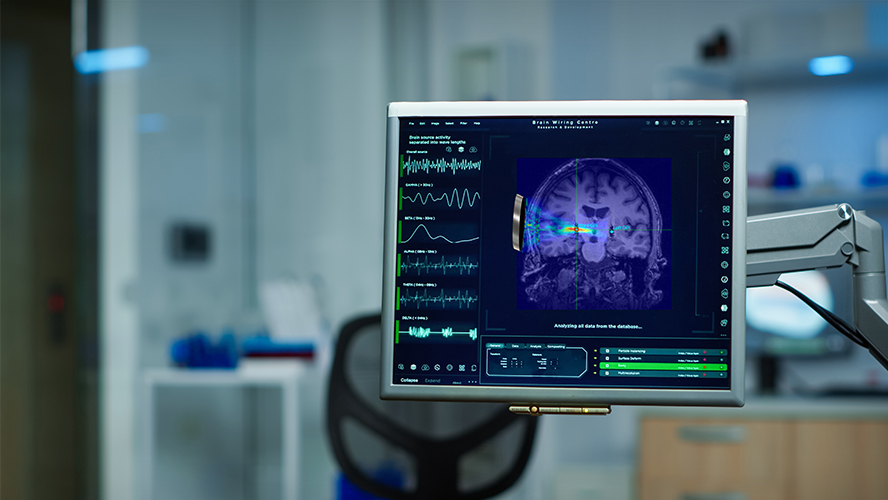
A recent study from UHN’s Krembil Brain Institute (KBI), published in Nature Communications, explored a promising new technique for treating movement disorders like Parkinson disease (PD). The researchers investigated transcranial ultrasound (TUS), which uses sound waves applied through the skull to target areas of the brain. This method could become the first non-invasive form of deep-brain stimulation.
Deep-brain stimulation (DBS), which involves applying high-frequency electrical stimulation to specific areas of the brain, is an effective way to manage the motor symptoms of PD. Traditionally, this requires surgery to implant electrodes into the part of the brain to be treated—such as the basal ganglia in PD. Although effective, the invasive nature of the procedure has limited access for some patients.
With TUS, patients could receive the benefits of DBS without surgery. A non-invasive approach like TUS could make DBS more widely available and reduce the risks and barriers traditional methods pose for some patients.
The KBI team, led by Senior Scientist Dr. Robert E. W. Chen, showed that TUS can precisely target small brain structures and control the activity of neurons within them in patients with PD. The study also found that PD patients’ response to TUS stimulation varied depending on the treatment’s settings and the amount of medication patients were taking to manage their symptoms. When the team applied TUS to the basal ganglia in healthy participants, it caused behavioral changes specific to that brain region—effects that were not seen when nearby areas were targeted.
Together, these findings suggest that TUS could offer symptom-relieving benefits similar to traditional DBS, but without the need for surgery. While future studies are needed to confirm these findings in more patients, or patients with disorders other than PD, the therapeutic potential of TUS cannot be ignored. As our understanding of this technology grows, so does its promise to reshape treatment for people with Parkinson disease and other movement disorders around the world.
The first author on this study is Dr. Ghazaleh Darmani, a Postdoctoral Researcher at the Krembil Brain Institute.
The senior author on this study is Dr. Robert E. W. Chen, a Senior Scientist at the Krembil Brain Institute and a Professor in the Temerty Faculty of Medicine at the University of Toronto.
This work was supported by the Canadian Institutes of Health Research, the Weston Family Foundation, and UHN Foundation.
Darmani G, Ramezanpour H, Sarica C, Annirood R, Grippe T, Nankoo JF, Fomenko A, Santyr B, Zeng K, Vetkas A, Samuel N, Davidson B, Fasano A, Lankarany M, Kalia SK, Pichardo S, Lozano AM, Chen R. Individualized non-invasive deep brain stimulation of the basal ganglia using transcranial ultrasound stimulation. Nat Commun. 2025 Mar 19;16(1):2693. doi: 10.1038/s41467-025-57883-7.




